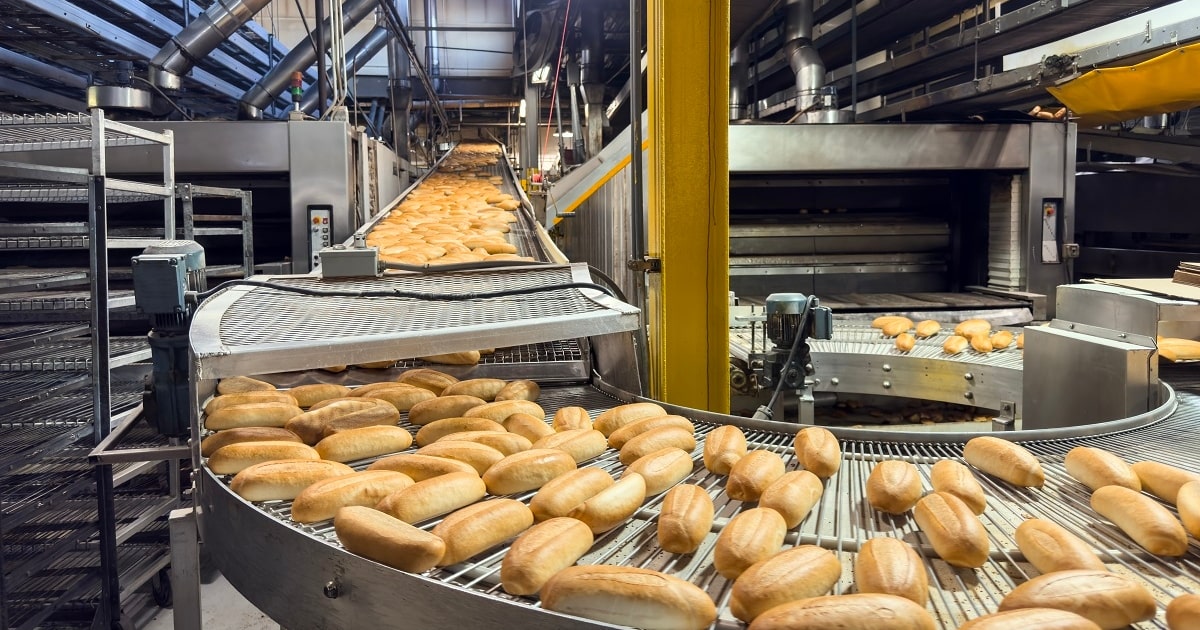Summary: AmTrust reviewed workers’ compensation claims data for the food manufacturing industry to look for the top causes of employee injuries, seasonal trends and more in the AmTrust 2023 Food Manufacturing Report. By understanding the common causes of injuries, companies can create workplace safety programs to help prevent them from happening in the future. 
Food manufacturing is one of the largest sectors within the manufacturing industry. It’s a unique industry where the work involves processing, packaging and transporting the food we buy at grocery stores or eat at restaurants. Food manufacturing employees work in diverse environments, often with specialized equipment and machinery that can cause injuries. The number of
nonfatal injuries and illnesses for workers in the food manufacturing industry is considerably higher than the overall private industry rate.
AmTrust analyzed over 15,000 workers’ compensation claims to help you understand the risks facing your workforce. We looked at food manufacturing industry claims data for the last four years to learn the following:
- The most common and expensive employee injuries
- Seasonal trends, including the impact of the pandemic closures
- Top causes of food manufacturing worker injuries
- Safety tips to prevent workplace injuries
Causes of Food Manufacturing Employee Injuries
Knowing workplace risks can help food manufacturing companies and employees avoid injuries. The top causes of common food manufacturing employee injuries:
- Strains
- Lacerations
- Contusions and Fractures
- Burns
Food manufacturing companies can help keep their workers safe by understanding the common causes of workplace accidents and how to prevent them from happening in the future.

Workplace Safety Tips for Food Manufacturing
Employee safety training is critical to a safe food manufacturing worksite. Management must provide personal protective equipment (PPE) and train staff on its proper use. The PPE worn by workers will vary depending on their job roles. Employees must know how to use the machinery safely and understand the company’s safety and training requirements, incident investigation and material handling.
Promoting
workplace safety to help reduce employee injuries and expensive claims is one way to help keep your workforce healthy and productive while keeping your
workers’ compensation premiums down.
To help prevent the most common food manufacturing worksite injuries, companies should follow these safety guidelines:
Slips, Trips and Falls
To help prevent slips, trips and falls, food manufacturing companies should have non-slip flooring and rubber mats for their workers to stand on. Walking surfaces should be kept clean, dry and free of trip hazards. Workers must wear non-slip, closed shoes in the plant to help prevent slips and falls. Guard rails must be placed around elevated platforms and open surface dip tanks. These rails must be securely attached and rails and mats must be in good condition.
Cuts (By Machinery)
To protect against cuts, workers should wear mesh gloves, wrist and forearm guards and aprons. Equipment like machinery and handheld tools should be examined regularly to ensure they are in good condition.
Strains
To help prevent the most common food manufacturing injury, sprains and strains, employers could provide adjustable-height workstations and seating, use anti-fatigue mats for prolonged standing, provide job-appropriate and well-fitting PPE, and set up a job rotation schedule for highly repetitive jobs.
Caught In Between Object
Employees should wear the appropriate protective equipment around pinch points and open machines. Employees should secure long hair and flowy clothing and remove jewelry that could get caught in a machine. Workers should never tamper with or remove machine guards.
Burns (Chemical Burns)
Workers exposed to hazardous chemicals that can cause burns as part of their job must be provided with the proper training and PPE, including gloves, goggles and a respirator.
Struck Against Object
Employers should implement and follow lockout/tagout (LO/TO) procedures to protect against moving machinery parts. Place warning signs and labels on conveyer belts to warn workers of potential hazards and injuries. Employees should wear the appropriate PPE, ensure all objects are correctly placed on shelves to prevent falling and secure all cart loads, dollies and trucks.
Motor Vehicle
Employees should follow safe driving procedures, including
driving without distractions.
Abrasions
To help mitigate the risk of abrasions, employers should install non-slip flooring, keep walkways clean, dry, and free of tripping hazards and require workers to wear slip-resistant shoes or boots.

AmTrust Helps Our Food Manufacturing Insureds Protect Their Workers
AmTrust’s food manufacturing insurance products and risk management solutions address critical exposures the food manufacturing industry faces. Implementing workplace safety tips like the above can help reduce the frequency and severity of employee injuries at food manufacturing companies.
AmTrust’s
Loss Control Department can identify specific hazards and offer solutions for your operation.
Download a copy of the AmTrust 2023 Food Manufacturing Report for a more in-depth look at the latest workers’ compensation claims data for the food manufacturing industry.
AmTrust is an industry leader in
workers’ compensation insurance for small to mid-sized businesses. For more information about our
small business insurance solutions, please
contact us today.
This material is for informational purposes only and is not legal or business advice. Neither AmTrust Financial Services, Inc. nor any of its subsidiaries or affiliates represents or warrants that the information contained herein is appropriate or suitable for any specific business or legal purpose. Readers seeking resolution of specific questions should consult their business and/or legal advisors. Coverages may vary by location. Contact your local RSM for more information.